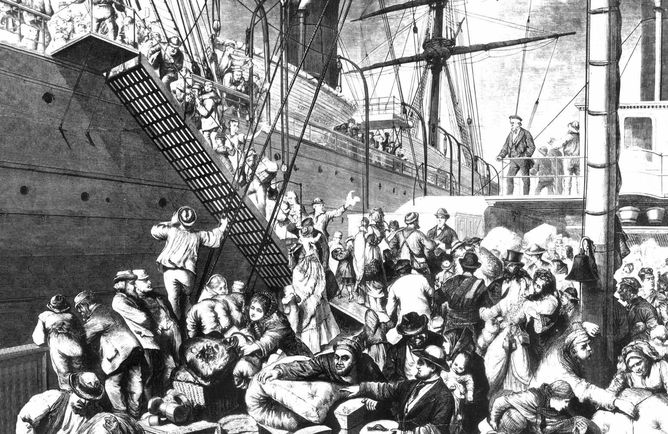This article was originally published on The Conversation. Read the original article.
The hysterical anti-migrant and anti-refugee rhetoric from the Republican candidates in the US presidential race has reached a fever pitch lately, with Donald Trump leading the charge. From advocating the building of a wall on the Mexican border to calling for Muslims to be banned from entering the US, he has taken some positions on “outsiders” that would make some of Europe’s staunchest right-wing populists blush.
But Trump could benefit from a little reflection on his own background. He himself is the grandson of a German immigrant, Friedrich Drumpf, who came to the US in 1885 – one of a great many Germans who settled in American society and helped make it what it is today.
From the 1820s onwards, about 7m Germans migrated to the US. In particular during the 19th century, German culture remained a distinctive element of US public life: German settlements, schools, associations, and churches existed alongside those of other migrant communities. These networks provided much needed emotional and practical support, and were a vital way to share impressions of the new country and news from “home”.
Compared to other immigrant groups coming to the US in large numbers, the Germans assimilated and eventually gave up most of their “ethnic” associations by the 1920s. But their distinctive experience among the groups who came to the US in this period speaks to today’s debates about immigration – and especially to the ways immigrants integrate into new societies.
Settling in
We’ve been working on a computer-aided textual analysis of about 6,000 letters sent between the US and Germany between 1830 and 1970. Their contents allow us to trace how migrants’ identities and transnational ties changed over the decades.
These letters were written by “ordinary” migrants, rather than members of the elite who were writing to be read. They were an important and authentic source of information about America for families and local communities in Germany who were experiencing the effects of mass emigration from the “home” end. Through the letters, migrants and their families compared life abroad and back home, and formed a vivid image of the US.
This map illustrates the origins of the letters, conforming to the familiar spatial and temporal pattern of migration. While some Germans left for Australia, Canada, and South America, those who went to the US settled in the Midwest and along the east coast. Their letters provide a rich insight into their experiences of migration over 150 years: they’re delighted by easy access to the labour market and higher salaries, for example, but also talk about the uncertainty of succeeding in the host country because of job insecurity and higher living costs.
In March 1940, Helene Heintze wrote from New York to her family in Germany:
One is worried about Germany’s fate, one is too much exposed to the English propaganda over here. And then, of course, the working conditions get on one’s nerves, as always, nothing to rely on, at one point you work like crazy and shortly afterwards you sit around at home again. […] One had actually expected something completely different from life and it is impossible to get out of this mess.
Ms Heintze’s first-hand account illustrates the meandering and always incomplete process of integrating into a new society and political system as well as the importance of maintaining links to family members and life “back home”.
She left Germany in the aftermath of World War I, and wrote at least three to four letters per year to her family and friends in Saxony. Initially settled in Chicago, we see her criticising America’s consumer culture and ruthless economic system, while embracing opportunities for women and a chance of social mobility she had never experienced in Germany. During the 1930s, she became increasingly interested in German politics. A lack of access to information and the openly anti-Germany public rhetoric in the US revived her emotional ties to her homeland during a moment of political crisis.
These ties to the families left behind did a lot to shape the overall positive image of the US in Germany, which was particularly strong in the middle of the 19th century and in the interwar period. The letters’ references to social modernisation and economic and political freedom, pointing to the considerable development gap between the two countries. The letters are a powerful expression of the inherent diversity of a sizeable group of immigrants as well as overarching patterns in their identities.
Feels like home

German immigrants’ feelings about the US and Germany varied greatly over time. Moments of crisis made them reconsider their identities and their relationship to both countries. For newly arrived Germans, having lost their local communities, quick reintegration into German networks was a crucial part of feeling at home in the US. To answer their questions on education, agricultural practice or financial investment, they relied on links back to fellow Germans in the US and in Germany.
For many of them, World War I and World War II triggered a higher level of interest in German society and politics. The fact that their ethnic origin came under renewed scrutiny made many of them feel “German” again.
President Theodore Roosevelt’s campaign against “hyphenated Americans” during World War I and the perceived lack of objective information about Germany in US media stimulated this ethnic identity. Some letters explicitly mention a wish to fight for Germany and a hope for Germany’s victory “over its enemies”.
There’s plenty here that we’d do well to remember today. The experience of the Germans demonstrates how immigrant integration is not a linear process, but a negotiated and multi-directional process that is measured in degrees. Migrants of all backgrounds living in any host society endorse and integrate into some aspects of life, but not others. This changes the host society as a result. The inherent diversity of any large immigrant population makes some degree of integration almost inevitable, as large and diverse groups can’t maintain overall ethnic unity outside the mainstream of the host country’s society. By contrast, restrictive policies and anti-immigrant rhetoric are likely to reinvigorate immigrants’ emotional ties to their country of origin.
And above all, critical events such as national crisis or war can reactivate immigrants’ political interest in and renewed identification with their original homeland, however “assimilated” they may have become in their new country. It’s unrealistic to expect immigrants to let go of their ties completely – but it’s equally naïve to think that letting them in is only a burden on (or liability for) the host country.
Explore Félix Krawatzek’s visualisation of letters of his research project “Political Remittances: Understanding the Political Impacts of Migration”
Explore the full version of the app here.








